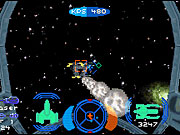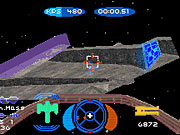Despite all the hype paid to the potential 3D capabilities of the Game Boy Advance throughout the years, very few games have come out that actually attest to the system's ability to present a playable product with graphics composed primarily of polygons. The recent Star X, an arcade-style space shooter, is a good example of how a company can push the GBA to its limits graphically without sacrificing much in the way of playability. Destination Software's latest effort, Wing Commander: Prophecy, goes a step further by overlaying textures on massive ships and then giving you the opportunity to fly around and attack them in a full 360-degree environment. There are a few rough spots here and there, but Prophecy is a breath of fresh air for anybody who's been craving a tough-as-nails mission-based shooter to play on the Game Boy Advance.

Even though this is the first Wing Commander game to appear on the Game Boy Advance, Prophecy is actually the fifth installment in the series. The game's story concerns an insectoid race known as the nephilim, who've swept in to pillage the galaxy after the defeat of the catlike kilrathi at the hands of humans. You play the part of a rookie pilot assigned to the carrier Midway, which has been commissioned to study and confront the new alien race. As is often the case in games such as this, heated fighting breaks out and you end up going off to save the universe by participating in a series of dogfight, escort, and reconnaissance missions.
When Prophecy originally came out for the PC, it was packaged on four compact discs and had hundreds of minutes of full-motion video. Obviously, much of this presentation had to be altered in order to fit the game onto a GBA cartridge. The majority of the character-interaction sequences have been watered down into still-frame cinematics with text boxes. The cutscenes have been reworked into game-engine graphics or sequences of still images. Of course, Mark Hamill's cheesy performance as Commander Christopher Blair just isn't the same when reduced to a glamour photo and paragraphs of white text. Even so, the developers managed to convey the game's Hollywood-esque atmosphere rather well. All the original dialogue is present, and the sweeping camera perspectives used during the game-engine-rendered cinematics help portray the nephilim as a larger-than-life adversary. There are also new full-motion video intro and ending sequences that serve as stirring bookends to the single-player campaign.
Most of the game's 48 missions center on destroying as many enemy ships as possible without getting killed. You'll acquire a wide array of gun and missile weapons the further you progress, as well as an ever-growing cast of wingmen, but the hardest part is conserving the two or three levels of shields you have until the next opportunity to refuel arises. Although there are a fair number of pure escort and dogfight missions, the most common assignment involves surviving from one navigation checkpoint to the next until reaching a large transport or battleship, which you then have to destroy by knocking out multiple defensive systems.
As impressive as Prophecy is on the Game Boy Advance, some aspects could have used a little more work. The throttle and aiming controls are cumbersome. Acceleration and deceleration require the use of the directional pad and the shoulder buttons, but these same buttons are also used to select weapons--which means you'll often find yourself switching guns whenever you accelerate. Visually, the amount of detail on the fishlike nephilim ships is so high that the action on the screen stutters whenever a handful of ships are present at the same time. The various space backgrounds aren't all that colorful either, which makes it difficult to see spacecraft approaching at a distance. Oftentimes, they blend in with the stars and planetoids in the scenery. Thankfully, the overall impact of these problems diminishes as you become acclimated to the controls and the various graphical quirks.
You probably won't be moved by the game's audio, which merely does the minimum to satisfy the requirements of a space-based shooter. You'll hear a few laser, ricochet, and explosion sound effects, and even though they're fairly loud, they're nothing special. The speech effects that come up before and after the missions are a nice touch, but the game could have used two dozen more of them during the actual gameplay. The nicest part of the soundtrack is the music that plays during each mission. Overdramatic as they are, these tracks do a fine job of filling in the silence between laser blasts.
Besides the lengthy single-player campaign, Prophecy also supports deathmatch and team battle modes for up to four players. Each player can have his or her own wingman, which translates into a maximum of eight ships onscreen at any given time. Except for the usual amount of choppiness that occurs when a group of ships is huddled together, the action in the multiplayer modes is smooth and responsive.
Wing Commander: Prophecy is a triumph on the Game Boy Advance, but it's not without its flaws. Given a bit more time to tweak the controls and further polish the graphics, Destination Software could have had a groundbreaking work on its hands. Instead, Prophecy is just a solid space combat game that will appeal to anyone looking for the likes of Wing Commander or Colony Wars on a handheld.
